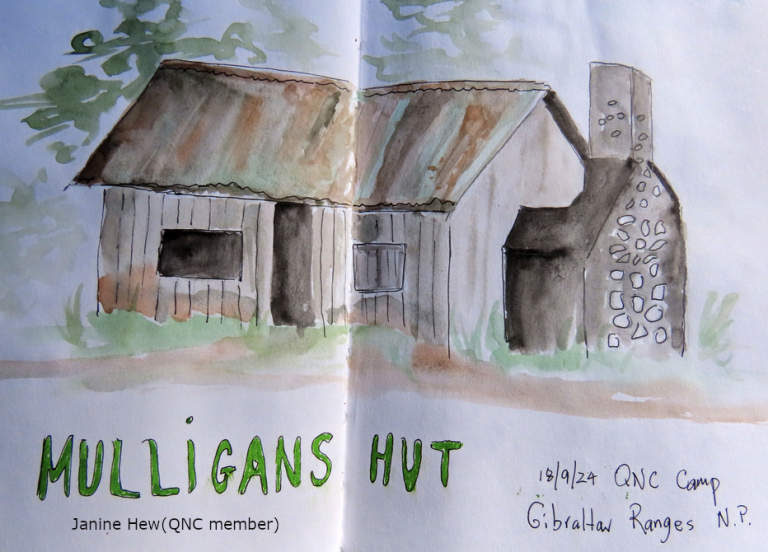
Excursion Report – Midweek Excursion to Gibraltar Range NP, NSW; held 17-22 Sept 24
Mid-week Excursion to Gibraltar Range NP, NSW
Leaders: Greg and Annie Neill
Gibraltar Range is a national park located in northeastern New South Wales. It is situated 79 km northeast of Glen Innes. The Park is part of the Washpool and Gibraltar Range area,which is designated as a World Heritage Site Gondwana Rainforests of Australia. The camp was located at Mulligans Hut group campsite with 23 attendees, the majority staying for the 5 nights. Day walks followed the tracks in the vicinity of the campground and visitors centre. For a complete list of birds recorded see eBird:
https://ebird.org/tripreport/27710
Twelve QNC members contributed to the iNaturalist Project which can be found at this link: https://inaturalist.ala.org.au/projects/qnc-sep-2024-gibraltar-range-np-camp
Many thanks to QNC members Tony Bean and Liz Date-Huxtable for providing their impressions of the excursion for this report. Also thanks to Janine Hew for her lovely sketches. The club had previously camped at the same location from 18 – 26th Sep, 1999.
A glimpse at the flora of Gibraltar Range by Tony Bean Queensland Herbarium
QNC members began arriving at Mulligans Hut camping area on Tuesday afternoon, 17th September, full of anticipation. The diversity of the flora was already in evidence along the drive in and around the campsite. The first outing on Wednesday was to Anvil Rock.
Our leaders reasonably allocated the morning for this outing, with another outing scheduled for the afternoon. However, the pace was very slow due largely to the abundance of flowering shrubs and vines as the trail passed through eucalypt forest and treeless heathlands, then granite outcrops. (It took us 3.5 hours to walk 2 km). Yellow andpurple flowers dominated. There were species of Pultenaea, Dampiera, Comesperma, Boronia, Tetratheca, Acacia, Leptospermum, Epacris and more. It was after midday before we reached Anvil Rock hence it was a late lunch back at the camp. The afternoon program was amended to an abbreviated walk to the nearby creek banks.
On Thursday we headed to Dandahra Crags. This walk traverses similar vegetation to theAnvil Rock walk, but quite a few extra species of flora were observed. One of the highlights was Conospermum burgessiorum, a much larger plant than the common C. taxifolium, and with larger leaves. It bore large terminal sprays of white flowers, visible from a large distance. On the crags, numerous unusual plants were seen, including Callitris monticola,a dwarf species of cypress pine with large grey cones, and Mirbelia confertiflora, a tall legume with prickly leaves and dense terminal heads of yellow flowers. On Friday we walked to “The Needles”, which turned out to be two granite monoliths pointing skyward at the edge of an escarpment. The track at first passed through relatively low eucalypt forest similar to that around the campsite. Soon this transformed into very tall forest of Eucalyptus campanulata with a shrub layer so dense it would be impossible to walk through without the benefit of a path. A little further on, with a change in the soil, the vegetation became temperate rainforest where Coachwood (Ceratopetalum apetalum) was a common or even dominant species.
Wherever there wasa canopy gap, pioneer species were in evidence, including Solanum nobile, a tall shrub or small tree of restricted distribution, and Polyscias murrayi, the Pencil cedar. Emerging from the rainforest zone, we again found ourselves in eucalypt forest, including somespecies more often seen near the coast e.g. Lophostemon confertus (Brush Box). The lookout at the Needles was another good place for flora with several notable species, such as the Fuchsia Heath (Epacris longiflora).On Saturday, we took a one-way walk loosely following Dandahra Creek downstream back to camp. The plant species seen were very similar to those seen on Wednesday and Thursday, including further examples of the endemic waratah (Telopea aspera) and Wattle-leaf peppermint (Eucalyptus acaciiformis). The eucalypts were challenging to identify partly because there is so little variation in the bark types. Nearly all species have grey fibrous to stringy bark extending well into the tree canopy. Around the campsite were Eucalyptus olida with its fragrant leaves, giving rise to the common name ‘Strawberry gum’ , and E. cameronii (Diehard Stringybark) with its distinctive small broad hairy juvenile leaves.
Within easy walking distance of the camp were Broad-leaved Stringybark (E.williamsiana), the only species observed to be flowering during our visit, E. radiata(Narrow-leaved peppermint) and E. deanei (Round-leaved gum). On the granite tors, we saw E. pyrocarpa (Pear-fruited blackbutt), whose fruits do not resemble pears in anyway, E. planchoniana (Needlebark) with its large ribbed fruits and E. notabilis (Blue Mountains mahogany). Other species seen during our time here, were E. saligna and E.microcorys. I for one, am keen to revisit Gibraltar Range as there is so much flora yet to see.
Some observations of the birds of Gibraltar Range NP by Liz (Date) Huxtable
Liz recorded bird lists from the recent QNC trip to Gibraltar Range, including sightings at Milligans Hut during 17th-20th September and on the Anvil Rock Walk on 18th September and The Needles Walk on 19th September. The last list is grouped into birds sighted in the woodland on granite and those in rainforest on basalt soil. The separation of bird communities was even more marked on The Needles walk than it was at Mulligans Hut Campground, where the northern side bordered rainforest and the southern side, woodland. There were some quite distinct changes in birds when walking from one side of the campground to the other. For example, Lewin’s Honeyeater in the north and New Holland Honeyeater in the south, Rose Robin north but Eastern Yellow Robin across both communities, Golden Whistler north and Rufous Whistler south.
On The Needles walk there was a pair of Grey Goshawks in tall forests bordering on the rainforest, whereas near Mulligans Hut campground a Brown Goshawk was sighted over woodland. White-browed Scrub-wrens were sighted in woodland and rainforest areas whereas Yellow-throated Scrub-wrens only in rainforest. The latter were quite active and vocal on the day we were walking to the Needles and there were several of their very distinctive nests sighted (see photos).
Annie Neill notes that most, if not all participants, were treated with good sightings of the Spotted-tailed quoll (Dasyurus maculatus). The quoll genus Dasyurus is endemic to Australia. With males and females weighing around 3.5 and 1.8 kg respectively, it is the world’s second largest extant carnivorous marsupial, behind the Tasmanian devil. Two subspecies are recognised, D. maculatus in the wet forests of southeastern Australia and Tasmania, and a northern subspecies D. m. gracilis found in a small area in northern Queensland. The Spotted-tailed quoll preys on small mammals, birds, insects and even larger marsupials like wombats. The species is listed as near-threatened on the IUCN Red List, and is primarily threatened by habitat loss caused by human activities.
